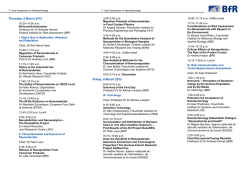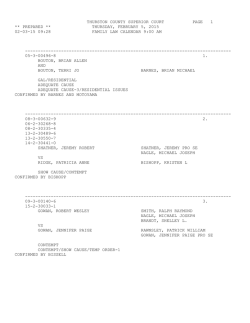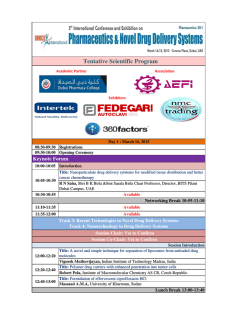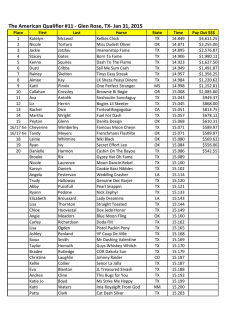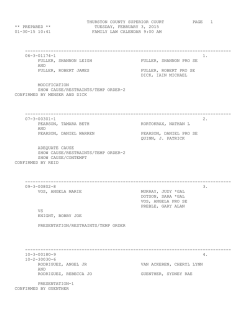
See conference agenda - Namur Research Institute for LIfe Sciences
Exploring the importance of Nanotechnology in linking diagnosis with treatment and development of personalised medicine EVENT OVERVIEW MarketsandMarkets conferences are proud to announce its Nanotechnologies in Drug Delivery Congress on the 27 – 28 April 2015 in London, United Kingdom. Bringing together 150+ industry and nanoscience related experts from the nanomedicine community in which drug delivery technologies alone are expected to reach $224 billion by 2017. The role of technology in the delivery of medicine guarantees revolutionary advances with measuring the size of the particles in nanometer ranges; this detailed analysis has helped improve the efficiency of drug delivery on a large scale. The application of drug delivery facilitates advanced treatment of cancer, cardiovascular, pulmonary, genetic, and infectious diseases and considers assessment and review procedures involved in the development of gene-based pharmaceuticals. Bringing together 25+ expert speakers from academia and industry, the two day program will examine key concerns in drug delivery including Nanotechnology drug enabled drug delivery in HIV therapy, siRNA, and blood protein analysis as well as exploring nanotechnology in medicine design. The conference will provide an interactive networking platform to highlight the innovations in one of the fastest growing drug delivery fields through keynote presentations, interactive panel discussions, case studies and an exhibition area where leading industry providers will showcase their products and services. 1 CONFIRMED SPEAKERS 1. Paul Stannard, Chairman, World Nano Foundation 2. Dr. Haydar Jaafar, Global Head – General Medical Devices, BSI Healthcare, UK 3. P rof. Dr. Patrick Hunziker, MD, University Hospital Basel, CSO, European Foundation for Nanmedicine (CLINAM) and President, International Society for Nanomedicine (ISNM), Basel, Switzerland 4. Prof. Andrew Owen, Professor of Molecular and Clinical Pharmacology, University of Liverpool, Chair, British Society for Nanomedicine, Liverpool, UK 5. Ms. Sonia Trigueros, Co-Director Oxford Martin Programme on Nanotechnology (Nanomedicine), University of Oxford, UK 6. Nathalie Mignet, CNRS Research Director, Team vectors for molecular imaging and targeted therapy, University Paris Descartes, Founder, French Society for Nanomedicine, France 7. John Giannios, President, Hellenic and International Society of Molecular and Genomic Medicine and Research, Head of Translational Medicine, Cancer Research and Regenerative Medicine of Erasinio Oncology Hospital, Athens, Greece 8. M arianne Ashford PhD, Principal Scientist Drug Targeting, Pharmaceutical Development, AstraZeneca, UK 9. Prof. Stephen Evans, Head of Molecular and Nanoscale Physics Group & Director of Research and Innovation, University of Leeds, UK 10.Prof. Dr. Vasilis Ntziachristos – Chair for Biological Imaging, Institute for Biological and Medical Imaging Technical University of Munich, Germany 11.Dr. Dionysius Douroumis - Director of the Centre for Innovation in Process Engineering and Research (CIPER), Department of Pharmaceutical, Chemical & Environmental Sciences, University of Greenwich, UK 12. Prof. Ijoema Uchegbu, Chair in Pharmaceutical Nanoscience, UCL School of Pharmacy, UK 13. Andrea Masotti, Gene Expression - Microarrays Laboratory, Bambino Gesù Children’s Hospital, IRCCS 14. Dr. Khuloud Al Jamal, Senior Lecturer in Nanomedicine, King’s College London, UK 15. Prof. Albert Mihranyan, Associate Professor & Senior Lecturer - Division of Nanotechnology, Uppsala University, Sweden 16. Prof. Nicola Tirelli, Professor of Polymers and Biomaterials, University of Manchester, UK 17. Dr. Christine Dufes, Senior Lecturer in Drug Delivery, University of Strathclyde, UK FOR REGISTRATION, CONTACT Badri Dash at [email protected] Tel: +91 20 6725 6057, +91 8411806334 2 Day 1 – 27th April 2015 – Monday 8.00 - Registration & Refreshments 8.50 – Welcome note by MnM & Morning Chair’s opening remarks KEYNOTE ADDRESS 9.00 The role of Nanomedicine and Targeted Medicine for Personalised Medicine Exploring the importance of Nanotechnology in linking diagnosis with treatment and development of personalised medicine Confirmed Prof. Dr. Patrick Hunziker, MD, University Hospital Basel, CSO, European Foundation for Nanmedicine (CLINAM) and President, International Society for Nanomedicine (ISNM), Basel, Switzerland KEYNOTE ADDRESS 9.20 European Medical Devices Regulation of Nanotechnologies in Drug Delivery Confirmed - Dr. Haydar Jaafar, Global Head – General Medical Devices, BSI Healthcare, UK SPECIAL ADDRESS 9.40 Growth of innovative drug delivery platforms – Importance & Benefits •Up to 50 percent of new drugs can’t be taken orally, so the impetus to create innovative delivery platforms is strong and growing • Growing demand for medications that can be self-administered at home • Increase in chronic diseases Speaker to be announced 10.00 Solution Provider Presentation For sponsorship opportunities please contact [email protected] 10.30 – Morning refreshments, Poster Presentations and one to one meetings SPECIAL ADDRESS 11.40 – Mission Nanotechnology 2015 Confirmed – Paul Stannard, Chairman, World Nano Foundation FOR REGISTRATION, CONTACT Badri Dash at [email protected] Tel: +91 20 6725 6057, +91 8411806334 3 SPECIAL ADDRESS 11.55 – Nanotechnology-enabled drug delivery in HIV therapy • Background to the application of nanomedicine in HIV treatment and pre-exposure prophylaxis •Development of orally available nanomedicines for antiretroviral dose reduction and paediatric applications • Opportunities for cellular and tissue targeting in HIV Confirmed - Prof. Andrew Owen, Chair - British Society of Nanomedicine, Professor of Pharmacology, University of Liverpool PANEL DISCUSSION 12.20 – Successfully sourcing new technologies from both academia and the industry •Using nanoscale fabrication techniques to investigate the device design with manageable surface properties as well as devices capable of functioning as biosensors and stimuli-sensitive delivery platforms •Magneto-electric nanoparticles are being developed as vehicles for delivering and releasing the anti-HIV drug AZTTP into the brain • Sugar-sensitive nanoparticles that release glucose can revolutionize diabetes treatment Confirmed Panelists Dr. Christine Dufes, Senior Lecturer in Drug Delivery, University of Strathclyde, UK 13.05 – Luncheon 14.05 – Solution Provider Presentation For sponsorship opportunities please contact [email protected] 14.30 Nanotechnology for Medicine: Smart drug delivery systems for cancer therapies Invited - Ms. Sonia Trigueros, Co-Director Oxford Martin Programme on Nanotechnology (Nanomedicine), University of Oxford, UK 14.55 – Solution Provider Presentation For sponsorship opportunities please contact [email protected] FOR REGISTRATION, CONTACT Badri Dash at [email protected] Tel: +91 20 6725 6057, +91 8411806334 4 15.20 – siRNA - Providing a completely new paradigm for disease treatment • Loading siRNA into silicon nanoparticles to reduce ovarian cancer •Developing a wide range of non-viral nanoparticles (ranging in size from 100–400 nm) capable of delivering siRNA to its target cell without eliciting toxic or immune-mediated side effects • Human clinical trials Invited: Prof. Dr. Vasilis Ntziachristos, Director, Institute for Biological and Medical Imaging, Germany 15.45 - Imaging Nanotechnologies fate in vivo: a help to faster drug delivery preclinical studies Confirmed - Nathalie Mignet, CNRS Research Director, Team vectors for molecular imaging and targeted therapy, University Paris Descartes, Founder, French Society for Nanomedicine 16.10 – Coffee, Poster Presentations & one on one meetings 16.50 - Blood protein analysis - Providing a sensitive assessment of health and disease with detection of blood molecular fingerprints • Cancer cell fingerprints in the blood can speed up childhood cancer diagnosis •Different types of tumour could be identified using a blood test which recognises the unique fingerprints produced by tumours Speaker to be announced 17.15 – Application of Nanoparticles for Discovery of Biomarkers •Biomarker harvesting is an underutilized application of nanoparticle technology and is likely to undergo substantial growth. •Functional polymer-coated nanoparticles can be used for quick detection of biomarkers and DNA separation. Speaker to be announced 17.40 – Biocompatible polymers to deliver drugs • Using polymers for controlled drug release • Design predictable, controlled delivery of bio active agents • Natural V/S Synthetic polymers Speaker to be announced 18.05 – End of Day 1 & Drinks reception FOR REGISTRATION, CONTACT Badri Dash at [email protected] Tel: +91 20 6725 6057, +91 8411806334 5 DAY 2 – 28TH APRIL 2015 - TUESDAY 8.30 – Registration & Refreshments SPECIAL ADDRESS 9.00 Personalised cancer medicine mediated by pharmacogenomics and tailored immunotargeting via nanotechnology Drug molecules,antisense oligonucleotides or antagomirs can be delivered to tumour cells via immunotargeting circumventing chemoresistant mechanisms such as MDR-1 of Pgp efflux pumps and biological milieu interactions via pegylation which circumvents RES elimination elimination.This allows binding of the immunotargeted nanosomal Trojan Horses onto the overexpressed receptors of tumour cells which leads to their endocytosis and subsequent intracellular release circumventing genomic and epigenomic chemoresistant mechanisms leading to the eradication of these metastatic tumour cells via apoptotic cell death or type I PCD with a subsequent bystander killing effect . Confirmed - John Giannios, President, Hellenic and International Society of Molecular and Genomic Medicine and Research, Head of Translational Medicine and Cancer Research 9.25 Mesoporous silica nanoparticles as a drug delivery system for anticancer therapy Confirmed - Dr. Dionysius Douroumis - Director of the Centre for Innovation in Process Engineering and Research (CIPER), Department of Pharmaceutical, Chemical & Environmental Sciences, University of Greenwich, UK 9.45 Solution Provider Presentation For sponsorship opportunities please contact [email protected] 10.10 – Morning refreshments, Poster Presentations and one to one meetings 11.20 Delivery across blood brain barriers using nanoneedles The wide variety of available nanotechnologies allows the selection of a nanoscale material with the characteristics best suited to the therapeutic challenges posed by an individual CNS disorder Confirmed - Dr. Khuloud Al Jamal, Senior Lecturer in Nanomedicine, King’s College London FOR REGISTRATION, CONTACT Badri Dash at [email protected] Tel: +91 20 6725 6057, +91 8411806334 6 11.45 Polyamine-coated carbon nanotubes allow efficient microRNAs delivery in endothelial cells The advent of nanotechnology offers novel possibilities for biomedical applications and drug delivery. Carbon nanotubes (CNTs) have recently gained high popularity as potential drug carriers, therapeutic agents and for applications in diagnosis. Pristine CNTs are not soluble in aqueous solutions because they have highly hydrophobic surfaces. Therefore, surface functionalization is required to solubilize CNTs and to render biocompatibility and low toxicity for their medical applications. CNTs are often functionalized with cationic molecules or polymers in order to interact electrostatically with negatively charged siRNAs or plasmid DNAs. In this study, pristine CNTs were functionalized with a high molecular weight (25 kDa) branched polyethyleneimine (PEI) polymer or polyamidoamine (PAMAM) dendrimer (ethylenediamine core, generation 6.0) to develop two effective delivery systems for transferring microRNA oligonucleotides into endothelial cells (ECs). We demonstrated that ECs can rapidly internalize the miRNA-carrying CNTs in the cytoplasm and that polymer-coated-CNTs exhibited lower toxicity than pristine CNTs and pure polymers. Most importantly, the CNTs mediated the intracellular delivery of functional miR-503, which subsequently regulates target gene expression and ECs behaviour. Confirmed A ndrea Masotti, Gene Expression - Microarrays Laboratory, Bambino Gesù Children’s Hospital, IRCCS PANEL DISCUSSION 12.10 Safety Issues of Nanoparticles for Diagnostics Potential toxic effects are a concern with in vivo use of nanoparticles but not with in vitro diagnostics, which forms the major portion of laboratory diagnostics. There are environmental concerns about the release of nanoparticles during manufacturing of nanoparticles and the environmental effects. Confirmed Panelist Professor Nicola Tirelli, Professor of Polymers and Biomaterials, University of Manchester, UK 12.45 – Luncheon 13.45 Using Nanomedicines to Address Therapeutic Index Challenges • High attrition rates continue to be a challenge in Pharmaceutical Industry • Over 70% of attrition is attributed to Therapeutic Index Challenges • Ability of Nanomedicines to change drug biodistribution • Examples of applications of Nanomedicines to improve Therapeutic Index in Oncology Confirmed - Marianne Ashford PhD, Principal Scientist Drug Targeting, Pharmaceutical Development , AstraZeneca FOR REGISTRATION, CONTACT Badri Dash at [email protected] Tel: +91 20 6725 6057, +91 8411806334 7 14.15 Molecular imaging modalities – Revolutionizing the way we look inside human body • Classical molecular imaging techniques with its strength & limitations • Application in oncology, neuroscience, cardiology, gene therapy, cell tracking, and theranostics • Understanding the challenges involved Speaker to be announced 14.40 Exploring nanotechnology in medicine design •Understanding the link between chemistry and the resulting nanoparticle allows for the design of nanoparticles with pharmaceutically advantageous functions. • Nanoparticles may be used to deliver peptide drugs to the brain • Nanoparticles may be used to enable oral absorption of hydrophobic drugs •Medicines for unmet clinical needs are being developed in which nanotechnology is an integral part of the final formulation. Confirmed - Prof. Ijoema Uchegbu, Chair in Pharmaceutical Nanoscience, UCL School of Pharmacy 15.05 – Coffee, Poster Presentations & one on one meetings CASE STUDY SESSION 15.45 – Porous alkali earth metal carbonates as enhancers of solubility for poorly soluble drugs •Mesoporous inorganic carriers featuring pores below 50 nm exhibit strong potential to enhance the solubility and biovailability of poorly soluble Type II and IV drugs by restricting the crystallization inside nanopores; •The potential of using mesoporous carbonates of alkali earth metals for drug delivery of Type II and IV drugs was explored; •First, the enhanced solubility effect was demonstrated for celecoxib and ketoprofen as model drugs by controlling the pore size distribution and solid-state properties of calcium carbonate; •Further, completely new structure of micro/mesoporous magnesium carbonate (Upsalite®) was developed for drug delivery and other industrial applications; • The enhanced solubility effect of Upsalite® was demonstrated for ibuprofen as a model Type II drug. Confirmed - Prof. Albert Mihranyan, Associate Professor & Senior Lecturer, Division of Nanotechnology – Uppsala University CLOSING PANEL DISCUSSION 16.10 – Cutting cost on delivery and formulations Targeted nanoparticles can be highly cost-effective, since thousands of molecules of an imaging or therapeutic agent can be delivered using a relatively small number of surface targeting agents such as IgGs. 16.45 Conference Close FOR REGISTRATION, CONTACT Badri Dash at [email protected] Tel: +91 20 6725 6057, +91 8411806334 8
© Copyright 2024
